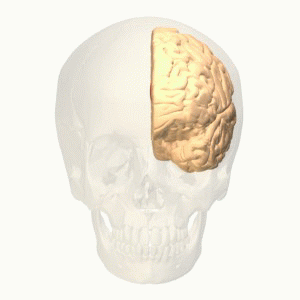「前帯状皮質」の版間の差分
細 (→出力) |
細 (→入力) |
||
| 38行目: | 38行目: | ||
===出力=== | ===出力=== | ||
入力部位と同様、一次運動野、および運動前野や補足運動野を含む高次運動野を中心とした広範な領域に出力する。また、大脳基底核の線条体や視床下核へ出力する。 | |||
一次運動野、補足運動野などの運動関連領野と同様、無顆粒皮質であり、皮質6層構造のⅣ層の顆粒層がない5層構造である。 | |||
==機能== | ==機能== | ||
2017年9月8日 (金) 11:46時点における版
岩田 潤一、嶋 啓節、虫明 元
東北大学 医学系研究科 (研究院)
DOI:10.14931/bsd.854 原稿受付日:2013年4月2日 原稿完成日:2016年7月12日
担当編集委員:一戸 紀孝(国立精神・神経医療研究センター 神経研究所)
英語名:anterior cingulate cortex 独:anteriore cinguläre Cortex 仏:cortex cingulaire antérieur
英略語:ACC
前帯状皮質は、大脳半球内側面の前方部に存在する、帯状溝周辺および帯状回の領域であり、ブロードマン24野、ブロードマン25野、およびブロードマン32野に相当する。ACCは特にヒトにおいて、担う機能の違いから、行動モニタリングおよび行動調節に関わる領域、社会的認知に関わる領域、および情動に関わる領域に大きく分かれる[1][2]。
構造
位置
前帯状皮質は、大脳半球内側面の前方部に存在する、帯状溝周辺および帯状回の領域であり、ブロードマン24野、ブロードマン25野、およびブロードマン32野に相当する。前帯状皮質は解剖学的に、あるいは機能の違いから、3つの領域に分類される。それらの領域の名称を下表に示す。ACCは特にヒトにおいて、担う機能の違いから、行動モニタリングおよび行動調節に関わる領域、社会的認知に関わる領域、および情動に関わる領域に大きく分かれる[1][2]。
| Vogt (2005)[1] | ||
| 前帯状皮質膝下部 (the subgenual anterior cingulate cortex, sACC) |
前帯状皮質膝前部 (the pregenual anterior cingulate cortex, pACC) |
中帯状皮質前方部 (the anterior midcingulate cortex, aMCC)* |
| Amodio and Frith (2006)[2] | ||
| 内側前頭皮質眼窩部 (the orbital medial frontal cortex, oMFC) |
内側前頭皮質吻側前方部 (the anterior region of the rostral medial frontal cortex, arMFC) |
内側前頭皮質吻側後方部 (the posterior region of the rostral medial frontal cortex, prMFC)* |
(*)一般的には前帯状皮質背側部(the dorsal anterior cingulate cortex, dACC)、あるいはRostral cingulate zone (RCZ)[3]と呼ばれる。
マカクザルで発見された前帯状皮質運動野(the rostral cingulate motor area, CMAr)は、これまでのヒト帯状皮質をRCZ(rostral cingulate zoneもしくは ACC:anterior cingulate cortex と名付ける:前部帯状野)、およびCCZ(rostral cingulate zone:後部帯状野)に2分する分類法ではCMArはACC(あるいはdACCと呼ぶこともある)に含まれる。ただし、Vogt (2005)の最近の分類、帯状皮質をACC(前帯状皮質)、MCC(中帯状皮質)およびPCC(後帯状皮質)に分類し、各々をさらに2分する分類法では、CMArは中帯状皮質前方部(the anterior midcingulate cortex, aMCC)の中に含まれていると考えられる。
入力
大脳辺縁系からの情報を強く受けている帯状回(内側表面として見える皮質凸部分)と多くの神経接続があり、帯状回を経由して海馬、扁桃核、視床下部などの皮質下の組織からの情報が入ってくる。また、前頭前野からは外側部だけでなく内側部、眼窩部からの広汎な入力がある。前頭葉からは運動前野、補足運動野、前補足運動野を含む広範な領域からの入力がある.頭頂間溝下部の下頭頂小葉および側頭葉中部および下部からの入力もある。また皮質下としては、中脳辺縁系ドーパミン入力がある。
出力
入力部位と同様、一次運動野、および運動前野や補足運動野を含む高次運動野を中心とした広範な領域に出力する。また、大脳基底核の線条体や視床下核へ出力する。
一次運動野、補足運動野などの運動関連領野と同様、無顆粒皮質であり、皮質6層構造のⅣ層の顆粒層がない5層構造である。
機能
行動モニタリング
前帯状皮質背側部(dACC)すなわち中帯状皮質前方部(aMCC)は行動モニタリングに関わる[4]。行動モニタリングにはコンフリクトモニタリングおよび行動成果モニタリングが含まれる。ヒトのdACCはStroop color-naming課題におけるように、2つ以上の行動を同時に惹起しうる状況(コンフリクト)において高い活動を示す[5]。またヒトのdACCは2つの行動から1つを選択して金銭を獲得する課題において、金銭獲得および金銭損失に関わる活動を示す[6]。
前帯状皮質背側部(dACC)すなわち中帯状皮質前方部(aMCC)は行動調節にも関わる[4]。dACC内部で帯状溝周囲に存在する、サルの吻側帯状皮質運動野(the rostral cingulate motor area, CMAr)は、報酬に基づく行動調節に関わる。報酬量に基づき2つの行動から1つを選択する課題において、サルのCMArは、報酬が減少し、且つ、サルがもう一方の行動に切り替える際に、活動を高める[7]。同様の活動がヒトのdACCにおいても認められる[8][9]。
報酬結果に基づく行動調節は、期待された報酬と実際の報酬の差(報酬予測誤差)を基盤にして説明される[10]。サルのCMArは、2つの行動のうち、報酬獲得に至る1つを探索する課題において、報酬予測誤差を反映する活動を示す[11]。さらにサルのCMArは、報酬獲得のための随意的行動調節において、報酬予測の手がかりとしての、自己の行動の時系列(行動文脈)を反映する活動を示す[12]。
サルのCMAr は運動そのものに関連する活動も示す。CMArは上肢運動の際に活動を示し、その活動は自己発動性の運動の時に、刺激誘導性の運動の時と比べ、より高い[13]。
社会的認知
ヒトの前帯状皮質膝前部(pACC)は社会的認知に関わる[2]。社会的認知には自己に関する判断、ヒトに関する判断、および他者の意図・信念の想像(メンタライジング;心の理論)が含まれる。pACCは、提示された言葉が自己に当てはまるのかどうかを判断する課題において、高い活動を示す[14]。
またpACCは、提示された形容詞がヒトに関わる名詞の前に来うるのかどうかを判断する課題において、高い活動を示す[15]。さらにpACCは、false belief課題(メンタライジング課題)において、被験者が物語を読んだ後、登場人物の意図・信念に関する質問に答える際に、高い活動を示す[16]。
情動・痛覚その他
ヒトの前帯状皮質膝下部(sACC)、pACC、およびdACCは、それぞれ異なる情動に関わる[1]。悲しみ・喜びの表情を提示される課題において、sACCは悲しい表情の提示の際、pACCは喜ばしい表情の提示の際、活動を高める[17]。 dACCは、恐れの表情あるいは恐れの声の提示を受けて、活動を高める[18]。
ACCは痛覚にも関わる。ヒトのACCにおいては、経皮温度刺激による痛覚を反映する活動はdACCを中心にみられ、内臓伸展刺激による痛覚を反映する活動はpACCを中心にみられる[1]。さらにヒトのACCは、他人が経験する痛みに関連して活動を示す。例えば、ヒトのACCは、他人が痛みを経験していることを知らせる手がかり刺激を目にする際、痛みを経験する他人の顔を目にする際、あるいは痛々しい状態の手あるいは足を目にする際に、活動を高める[19]。
またヒトのdACCは、社会的疎外の経験で生じる不快感(社会的痛み)を反映する活動を示す[20]。
まとめ
以上をまとめると、霊長類、特にヒトにおいて、行動モニタリングと行動調節はdACCで、社会的認知はpACCで、および情動は種類に応じてACC内の異なる領域で担われている。
関連項目
参考文献
- ↑ 1.0 1.1 1.2 1.3 1.4
Vogt, B.A. (2005).
Pain and emotion interactions in subregions of the cingulate gyrus. Nature reviews. Neuroscience, 6(7), 533-44. [PubMed:15995724] [PMC] [WorldCat] [DOI] - ↑ 2.0 2.1 2.2 2.3
Amodio, D.M., & Frith, C.D. (2006).
Meeting of minds: the medial frontal cortex and social cognition. Nature reviews. Neuroscience, 7(4), 268-77. [PubMed:16552413] [WorldCat] [DOI] - ↑
Picard, N., & Strick, P.L. (1996).
Motor areas of the medial wall: a review of their location and functional activation. Cerebral cortex (New York, N.Y. : 1991), 6(3), 342-53. [PubMed:8670662] [WorldCat] [DOI] - ↑ 4.0 4.1
Ridderinkhof, K.R., Ullsperger, M., Crone, E.A., & Nieuwenhuis, S. (2004).
The role of the medial frontal cortex in cognitive control. Science (New York, N.Y.), 306(5695), 443-7. [PubMed:15486290] [WorldCat] [DOI] - ↑
Botvinick, M., Nystrom, L.E., Fissell, K., Carter, C.S., & Cohen, J.D. (1999).
Conflict monitoring versus selection-for-action in anterior cingulate cortex. Nature, 402(6758), 179-81. [PubMed:10647008] [WorldCat] [DOI] - ↑
O'Doherty, J., Kringelbach, M.L., Rolls, E.T., Hornak, J., & Andrews, C. (2001).
Abstract reward and punishment representations in the human orbitofrontal cortex. Nature neuroscience, 4(1), 95-102. [PubMed:11135651] [WorldCat] [DOI] - ↑
Shima, K., & Tanji, J. (1998).
Role for cingulate motor area cells in voluntary movement selection based on reward. Science (New York, N.Y.), 282(5392), 1335-8. [PubMed:9812901] [WorldCat] [DOI] - ↑
Bush, G., Vogt, B.A., Holmes, J., Dale, A.M., Greve, D., Jenike, M.A., & Rosen, B.R. (2002).
Dorsal anterior cingulate cortex: a role in reward-based decision making. Proceedings of the National Academy of Sciences of the United States of America, 99(1), 523-8. [PubMed:11756669] [PMC] [WorldCat] [DOI] - ↑
O'Doherty, J., Critchley, H., Deichmann, R., & Dolan, R.J. (2003).
Dissociating valence of outcome from behavioral control in human orbital and ventral prefrontal cortices. The Journal of neuroscience : the official journal of the Society for Neuroscience, 23(21), 7931-9. [PubMed:12944524] [PMC] [WorldCat] - ↑ Richard S Sutton, Andrew G Barto
Reinforcement learning: An introduction.
(MIT Press, Cambridge, MA):1998 - ↑
Matsumoto, M., Matsumoto, K., Abe, H., & Tanaka, K. (2007).
Medial prefrontal cell activity signaling prediction errors of action values. Nature neuroscience, 10(5), 647-56. [PubMed:17450137] [WorldCat] [DOI] - ↑
Iwata, J., Shima, K., Tanji, J., & Mushiake, H. (2013).
Neurons in the cingulate motor area signal context-based and outcome-based volitional selection of action. Experimental brain research, 229(3), 407-17. [PubMed:23455722] [WorldCat] [DOI] - ↑
Shima, K., Aya, K., Mushiake, H., Inase, M., Aizawa, H., & Tanji, J. (1991).
Two movement-related foci in the primate cingulate cortex observed in signal-triggered and self-paced forelimb movements. Journal of neurophysiology, 65(2), 188-202. [PubMed:2016637] [WorldCat] [DOI] - ↑
Johnson, S.C., Baxter, L.C., Wilder, L.S., Pipe, J.G., Heiserman, J.E., & Prigatano, G.P. (2002).
Neural correlates of self-reflection. Brain : a journal of neurology, 125(Pt 8), 1808-14. [PubMed:12135971] [WorldCat] [DOI] - ↑
Mitchell, J.P., Heatherton, T.F., & Macrae, C.N. (2002).
Distinct neural systems subserve person and object knowledge. Proceedings of the National Academy of Sciences of the United States of America, 99(23), 15238-43. [PubMed:12417766] [PMC] [WorldCat] [DOI] - ↑
Fletcher, P.C., Happé, F., Frith, U., Baker, S.C., Dolan, R.J., Frackowiak, R.S., & Frith, C.D. (1995).
Other minds in the brain: a functional imaging study of "theory of mind" in story comprehension. Cognition, 57(2), 109-28. [PubMed:8556839] [WorldCat] [DOI] - ↑
George, M.S., Ketter, T.A., Parekh, P.I., Horwitz, B., Herscovitch, P., & Post, R.M. (1995).
Brain activity during transient sadness and happiness in healthy women. The American journal of psychiatry, 152(3), 341-51. [PubMed:7864258] [WorldCat] [DOI] - ↑
Dolan, R.J., Morris, J.S., & de Gelder, B. (2001).
Crossmodal binding of fear in voice and face. Proceedings of the National Academy of Sciences of the United States of America, 98(17), 10006-10. [PubMed:11493699] [PMC] [WorldCat] [DOI] - ↑
Keysers, C., Kaas, J.H., & Gazzola, V. (2010).
Somatosensation in social perception. Nature reviews. Neuroscience, 11(6), 417-28. [PubMed:20445542] [WorldCat] [DOI] - ↑
Eisenberger, N.I. (2012).
The pain of social disconnection: examining the shared neural underpinnings of physical and social pain. Nature reviews. Neuroscience, 13(6), 421-34. [PubMed:22551663] [WorldCat] [DOI]
